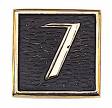Smashing Color Theory Blog Posts
Most traditional color theories are designed to simplify a complex topic. This oversimplification leads to assumptions about color that are misleading and often just plain wrong. Contrary to traditional theory . . . .
 Color Families are NOT the Same Size
Color Families are NOT the Same Size
Conclusions: Colors fall into six different sized families. Orange and Yellow are small families. Purple and Blue are middle size families. Red is a large family you can think of as divided into two sides of the family: Magenta Reds and Scarlet Reds. Green is a huge family you can think of as divided into the Emerald Greens and the Lime Greens.
Tutorial on the Three Properites of Color
Conclusions: Color has three properties: Hue=color family, Value=amount of light reflected, Saturation=proportion of pure hue. In addition to the six(plus two) hue families, colors fall into three value families; lights, mediums and darks, and four saturation families; rainbows, earths, rainbow pastels and earth pastels.
The properties are interconnected. When you change one property of a color it causes a shift in one or both of the other properties. When you have three properties you need a model that is 3D.
 Red is NOT a Primary
Red is NOT a Primary
Conclusions: Red is a psychological primary color; but not a mixing primary color.
Magenta is the primary mixing red of pigments. Reds are secondary mixes of Magentas and Yellows.
 Perfect Primaries are NOT Possible
Perfect Primaries are NOT Possible
Conclusions: Pure primaries are possible with Light, but not with Pigments. Pigments are manufactured to be as close as possible to pure primaries but every color has a bias; leaning to one side or the other of the theoretical pure color. This bias means that all primary colors have a little bit of another primary color in their makeup. A triangle is better than a circle to show bias.
There are many color systems for mixing pigments that are based on using just three primaries. One popular system is Red, Yellow, and Blue. These primaries will make a color that is close to black but will not make clear secondaries. Another popular system is Cyan, Magenta and Yellow.
These primaries will never make black but will make clearer secondaries. There are no three primaries that will make all colors.
Conclusions: Mud is in the middle.
 Half and Half is NOT Halfway
Half and Half is NOT Halfway
Tutorial on Tinctoral Strength
Conclusions: Not all colors have the same strength. The amount and type of pigments used in their makeup will determine which colors are “bullies” and which are “wimps.”
You cannot tell a color’s strength by looking at it. Some dark colors are weaker than lighter colors. Reds are usually bully colors.
 Mixing Complements will NOT Make Neutrals
Mixing Complements will NOT Make Neutrals
Conclusions: If neutrals are defined as the center of the color wheel, and the center is where all three primaries are present in equal amounts, then the theoretical formula for neutrals is 1:1:1. A primary and complementary mixed in equal amounts will have the formula 2:1:1. The primary color is 2 parts of the mix and the secondary adds one part of each of the other primaries to the mix.
The half and half mix will be a muddy color that is closer to the primary than the secondary. Blues mixed with oranges will make blue muds: teals, slates, indigos and grays. Reds mixed with greens will make red muds: russets, wines, bricks and maroons. Yellows mixed with violets will make yellow muds: golds, bronzes, caramels, and umbers. Intermediaries mixed with a complement in equal amounts will come closer to a 1:1:1 mix.
The theoretical formula for mixing a neutral from a primary and complement is 1:2 – 1 part primary to 2 parts complement – but the tinctoral power and makeup of each color will determine the actual proportions needed to get to a neutral.




October 19, 2011 at 8:46 am
This course was T E R R I F I C F U N !!!!!
It was just what I needed to put me back into my little art space at home; I’m having so much fun experimenting with painting now I have a much better idea how color works – where colors live and how to mix them to get a particular color, how and when to use black, Payne’s gray, the umbers, & white, how to draw with color, etc., etc., etc.
Take this course; you’ll be glad you did!